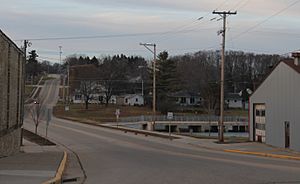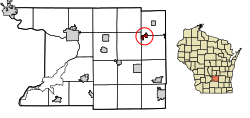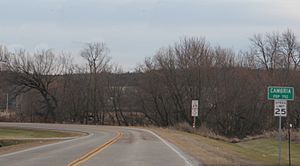Cambria, Wisconsin facts for kids
Quick facts for kids
Cambria, Wisconsin
|
|
|---|---|
|
Village
|
|

Looking north up WIS 146 in Cambria
|
|
| Motto(s):
"A Growing Community"
|
|

Location of Cambria in Columbia County, Wisconsin
|
|
| Country | United States |
| State | Wisconsin |
| County | Columbia |
| Area | |
| • Total | 1.03 sq mi (2.67 km2) |
| • Land | 0.98 sq mi (2.54 km2) |
| • Water | 0.05 sq mi (0.13 km2) |
| Elevation | 915 ft (279 m) |
| Population
(2010)
|
|
| • Total | 767 |
| • Estimate
(2019)
|
748 |
| • Density | 763.27/sq mi (294.6/km2) |
| Time zone | UTC-6 (Central (CST)) |
| • Summer (DST) | UTC-5 (CDT) |
| Area code(s) | 920 |
| FIPS code | 55-12200 |
| GNIS feature ID | 1562559 |
| Website | Village of Cambria |
Cambria is a small village in Columbia County, Wisconsin, United States. It is part of the Madison Metropolitan Statistical Area. In 2020, the population was 777 people.
Contents
History of Cambria
Early Settlers and Names
The story of Cambria began in 1844. Two brothers, John and Samuel Langdon, settled in this area. Samuel built a sawmill on a branch of Duck Creek. His brother opened a small store.
They planned out four blocks for a village and named it Florence. But because the sawmill was so important, people often called the settlement Langdon's Mills.
Welsh Immigrants Arrive
In 1845, about fifty Welsh people, including families, arrived from North Wales. Many came from a town called Dolwyddelan. They had traveled a long way to find a new home.
They sailed from Liverpool, England, to New York City. From there, they traveled by steamboat to Albany, New York. Then they took another steamboat across the Great Lakes to Milwaukee and Racine, Wisconsin.
A group of men then walked westward to find a good place to settle. They explored the land, looking for good soil, timber, and water. They decided on a beautiful spot in what is now Columbia County.
By mid-October 1845, these Welsh families had moved to their new farms. They lived in simple homes, but they were happy to have found their "promised land." This group hoped to create a Welsh community in Wisconsin.
Changing the Village Name
In 1848, the Langdon brothers tried to build a gristmill (a mill for grinding grain). But they ran out of money. In 1849, a man named Mr. Bell helped them. He took over the property and named the village Bellville after himself.
Mr. Bell ran the mill until 1851. Then, John Jones and Evan Edwards bought everything from him. The new owners and the Welsh settlers did not like the name Bellville. So, they changed it to Cambria. This name is the old Latin name for Wales, honoring the many Welsh people who lived there.
The village officially became a town in 1866. It started to grow more after a railroad was built through the area in 1857.
Recent Events
In 2017, there was an explosion at the Didion Milling Co. plant in Cambria. This was a very serious event for the community. The plant was later rebuilt.
Geography of Cambria
Cambria is a small village. According to the United States Census Bureau, the village covers about 1.04 square miles (2.67 square kilometers). Most of this area is land, with a small part being water.
Population and People
| Historical population | |||
|---|---|---|---|
| Census | Pop. | %± | |
| 1870 | 72 | — | |
| 1880 | 519 | 620.8% | |
| 1890 | 524 | 1.0% | |
| 1900 | 561 | 7.1% | |
| 1910 | 660 | 17.6% | |
| 1920 | 679 | 2.9% | |
| 1930 | 671 | −1.2% | |
| 1940 | 688 | 2.5% | |
| 1950 | 633 | −8.0% | |
| 1960 | 589 | −7.0% | |
| 1970 | 631 | 7.1% | |
| 1980 | 680 | 7.8% | |
| 1990 | 768 | 12.9% | |
| 2000 | 792 | 3.1% | |
| 2010 | 767 | −3.2% | |
| 2019 (est.) | 748 | −2.5% | |
| U.S. Decennial Census | |||
2010 Census Information
In 2010, there were 767 people living in Cambria. There were 301 households, which are groups of people living together in one home.
Most of the people in Cambria were White (91.7%). About 12.1% of the population identified as Hispanic or Latino.
The average age in the village was 35.7 years old. About 28.7% of the residents were under 18 years old.
Transportation
Cambria is located at the end of a Wisconsin and Southern Railroad branch line. This line connects Cambria to Horicon.
Notable People from Cambria
Many interesting people have connections to Cambria. Here are a few:
- W. R. Davies, who was the second president of the University of Wisconsin–Eau Claire.
- David R. Jones, a well-known architect.
- Davy Jones, a professional Major League Baseball player.
- Evan O. Jones, who served as a Wisconsin State Senator.
- William Owen, a Wisconsin State Representative.
- Samuel Owens, also a Wisconsin State Representative.
- Edward D. Roberts, who was the California State Treasurer.
- Edwin Myrwyn Rowlands, a Wisconsin State Senator.
- Gena Rowlands, a famous actress.
- Victor W. Voorhees, another notable architect.
See also
 In Spanish: Cambria (Wisconsin) para niños
In Spanish: Cambria (Wisconsin) para niños



